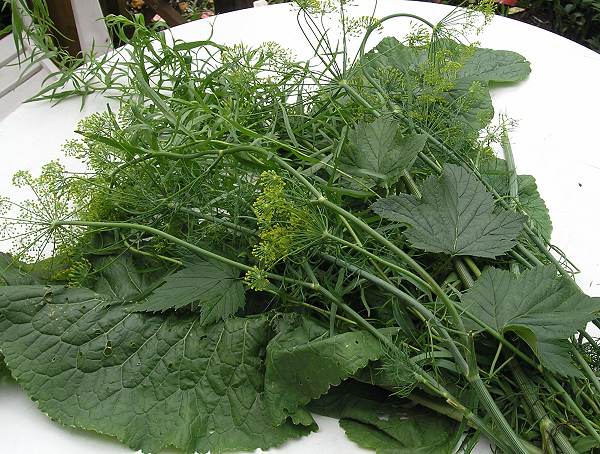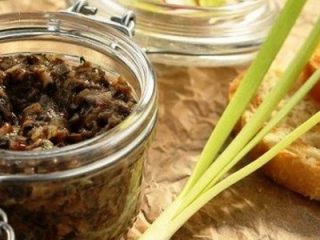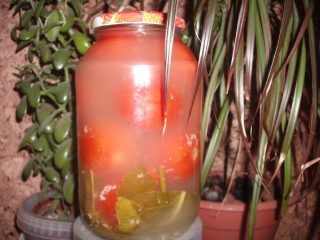Content
- 1 How to pickle tomatoes for the winter
- 2 Classic recipe for salted tomatoes in jars for the winter
- 3 How to simply pickle tomatoes for the winter
- 4 How to salt tomatoes in jars for the winter
- 5 Salted tomatoes in jars with herbs and garlic
- 6 How to deliciously salt tomatoes for the winter with horseradish
- 7 Salted tomatoes for the winter: recipe with tarragon
- 8 How to salt tomatoes in jars with celery and hot peppers
- 9 How to salt tomatoes with cloves and cinnamon
- 10 Pickling tomatoes for the winter with vinegar
- 11 Salting tomatoes in jars with vegetable oil for the winter
- 12 Rules for storing salted tomatoes in jars
- 13 Conclusion
Pickling tomatoes for the winter is one of the most interesting and healthy types of tomato preparation. After all, salted or pickled fruits retain both the natural taste and the special tenderness of the product, unlike pickled vegetables made with vinegar.
How to pickle tomatoes for the winter
The phrase “pickling tomatoes” certainly brings to mind luxurious oak barrels in which the sacred act takes place - the transformation of tomatoes under the influence of salt, sugar and spices into a salty product. But in modern small apartments there is nowhere to even place such barrels. In addition, it is not easy to find such containers now, and they are very expensive. Therefore, for many decades, a variety of glass containers have been especially popular for pickling tomatoes.It can be of various sizes: from 0.5 l to 5 l, or even 10 l. Although three-liter and liter jars remain the most popular. After all, in the first place you can prepare an excellent dish for a holiday table, and salted tomatoes, prepared for the winter in liter jars, are suitable for regular consumption by a small family of 2-3 people.
In addition, it is even easier to cook salted tomatoes in jars than in barrels - there is no need to use pressure. Also, distributing the fruits during pickling among many jars provides some additional insurance. If suddenly tomatoes in one jar turn sour for some reason, this will not affect other containers.
As for the choice of the fruits themselves for pickling, there are the following rules that it is advisable to adhere to:
- Usually, for pickling, oval-shaped tomato varieties, the so-called cream, are chosen: De Barao, Aquarelle, Cream Giant, Rocket, Cio-Cio-San and others.
- In principle, tomatoes of other shapes are suitable if they have thick skin and fleshy pulp.
- It is better to select unripe fruits, since ripe tomatoes require especially careful handling during the pickling process and often lose their shape.
- You can even pickle green tomatoes, but fruits damaged by disease or for other reasons must be discarded.
- For pickling in jars for the winter according to various recipes, it is more convenient to use small or medium-sized tomatoes. It is better to prepare juice from giant fruits or, if they have dense pulp, then preserve them in slices.
- Regardless of the recipe, tomatoes for winter preparation should be collected in dry weather and stored until processed, laid out on a horizontal surface in one row.
- If possible, it is better not to mix tomatoes of different varieties in one container - they may behave too differently.
- To avoid cracking of the fruits when pickling, they are usually pierced in several places with a toothpick.
If we compare the technology of pickling tomatoes with pickling cucumbers, the processes are very similar, but there are some differences:
- Due to the higher sugar content in tomatoes, they require more salt. According to the classic recipe, brine for ripe fruits is prepared using 500-600 g of salt per 10 liters of water. When pickling green tomatoes, you will need even more salt - 600-800 g per 10 liters of water.
- Since tomatoes have a more pronounced taste and aroma, they will need less spices and seasonings.Attention! But to preserve the strength and elasticity of the fruit, just as when pickling cucumbers, oak, cherry and horseradish leaves are used.
- The fermentation process in tomatoes proceeds more slowly than in cucumbers, so pickling will take much longer. On average - about two weeks, if the fermentation temperature is within + 15 ° C + 20 ° C. And at temperatures from 0 to + 5 ° C, pickling tomatoes can last from 1.5 to 2 months.
How much salt do you need for a liter jar of tomatoes?
Calculating the number of tomatoes per glass container is quite simple - densely packed fruits usually occupy half the volume of the jar. Although depending on the size, more or less of them can fit. Accordingly, one jar requires half the volume of brine.
A standard three-liter jar does not hold 3 liters at all, but more than 3.5 liters if you pour liquid up to the very neck. Therefore, the brine is usually prepared a little more than necessary.
The easiest way to salt tomatoes is in liter jars, since the contents of 1 container are usually enough for just one meal. And, given that the jar holds 1100 ml of liquid under the neck, you will need:
- about 500g medium-sized tomatoes;
- 600 g brine.
As for salt, remembering the proportions is quite easy, since the standard consumption for a 1-liter jar is exactly 1 tablespoon. Reducing the amount of salt is undesirable, as this may negatively affect the preservation of tomatoes. But it’s not too scary to slightly overdo it with this spice, since it is believed that tomatoes will not take in more than the amount they need for fermentation.
Classic recipe for salted tomatoes in jars for the winter
To salt tomatoes in jars for the winter according to the classic recipe, you will need the following components:
- 1.4 kg of tomatoes;
- about 1 liter of water;
- 4 cloves of garlic;
- 25 g sugar;
- 1 tbsp. l. dill or caraway seeds;
- 2 leaves of horseradish;
- 50-60 g salt.
This amount of ingredients will yield approximately 2 liter jars of salted tomatoes.
For any recipe for pickling tomatoes in jars, before use, glassware is thoroughly washed and sterilized over steam or using modern kitchen appliances: convection oven, microwave, sterilizer. It is enough to boil the lids for canning for 5-8 minutes in water.
Tomatoes, fresh spices and herbs are rinsed in cool water and slightly dried.
The process of pickling a tomato per liter of brine is as follows:
- At the bottom of the jars place 1 leaf of horseradish, other aromatic herbs and other spices prepared according to the recipe.
- Selected and prepared fruits are placed as tightly as possible on the spices.
- Some of the prepared spices are placed in the middle of the jar, and the tomatoes are also covered on top with a horseradish leaf.
- A liter of water is heated to + 100 °C, 60 g of salt and 25 g of sugar are added and boiled until they are completely dissolved.
- The brine is cooled and filtered, after which it is poured into the fruits in jars up to the neck.
- Cover with plastic lids and leave for 3-4 days to activate fermentation.
- If you have a cold cellar where you can store an almost unlimited number of jars with preparations, then it is better to send the salted tomatoes there immediately. They will be ready no earlier than in 40-45 days.
- If storage space with a temperature of about 0 + 5 ° C is limited, then after fermentation at room temperature for about 5-6 days, it is better to roll up the jars of tomatoes.
- To do this, the brine is drained and boiled for about 2-3 minutes. Tomatoes with seasonings are washed with hot water and placed in newly sterilized jars.
- Pour in hot brine, let stand for 5 minutes and drain the brine again using special lids with holes.
- Heat the brine to a boil, pour it over the tomatoes and screw on with sterile lids.
- Jars of salted vegetables are cooled upside down under a blanket and then stored.
How to simply pickle tomatoes for the winter
You can pickle tomatoes for the winter using a very simple recipe. To do this you only need:
- 1.5 kg of tomatoes;
- 1 liter of water;
- 80 g salt.
You can use any spices you wish, or you can not use them at all.
- To prepare this recipe, you need to place a plastic bag in the jar, the size of which is equal to or slightly larger than its volume.
- Place the tomatoes in a bag and pour in a pre-prepared brine of salt and water.
- Once the bag is full, squeeze the free end to release excess air and tie it tightly.
- To ensure sealing, the ends of the bag are melted using a hot iron.
- After which the jar can be closed with any lid and placed in a cool place.
- Salted tomatoes will be ready in a month and a half.
How to salt tomatoes in jars for the winter
Many people think about how to salt tomatoes for the winter so that they turn out to be as natural as possible and at the same time tasty, but at the same time complete the entire harvesting process in 1 day. There is also a simple recipe for this.
You will need:
- 2 kg of dense tomatoes;
- 50 g parsley root;
- 2 bay leaves;
- 4 cloves of garlic;
- a few horseradish leaves;
- 100 g dill inflorescences;
- 5 black peppercorns;
- at least 50 g of salt or more to taste.
The manufacturing technology is reminiscent of pickling tomatoes using the double-pouring method, only without adding vinegar.
- Parsley is peeled and cut into small pieces.
- At the bottom of the jars place chopped dill inflorescences, bay leaves, black peppercorns, garlic and part of the parsley rhizomes.
- Next, lay the tomatoes, somewhere in the middle making another layer of spicy rhizomes.
- Top the tomatoes with a horseradish leaf.
- Fill the jars with boiling water to the very top, set aside for 10-15 minutes.
- Using special lids with holes, the hot water is drained and a brine is prepared from it.
- They are again poured over the tomatoes with spices and the jars are immediately rolled up with sterile lids.
You can try tomatoes pickled according to this recipe after 2-3 weeks, but they become especially tasty after a month or two.
Salted tomatoes in jars with herbs and garlic
If you add another 50 g of parsley, dill and basil to the ingredients of the previous recipe, and take a small head of garlic, you can get a more spicy taste of the prepared salted tomatoes.
How to deliciously salt tomatoes for the winter with horseradish
You can also add 1-2 small horseradish rhizomes to everything else listed in the recipe above. By cutting them into small pieces and placing them in jars along with parsley rhizomes, you can ensure that salted tomatoes have a sharp and strong consistency.
Salted tomatoes for the winter: recipe with tarragon
A few sprigs of tarragon will give salted tomatoes a unique taste and fragrant aroma. The manufacturing technology is similar, and the ingredients for this recipe are the following:
- 5 kg of tomatoes;
- 80 g dill;
- 3 heads of garlic;
- 30 g tarragon;
- 4 liters of water;
- 200 g salt.
How to salt tomatoes in jars with celery and hot peppers
Well, lovers of spicy preparations should definitely like the recipe for salted tomatoes, consisting of the following ingredients:
- 5 kg tomato;
- 8 pcs. sweet pepper;
- 2 pods of hot pepper;
- 150 g celery;
- 100 g of greens and dill inflorescences;
- 4 liters of water;
- 250 g salt.
How to salt tomatoes with cloves and cinnamon
But this recipe can amaze with its originality, since the tomatoes turn out to be sweet rather than salty.
You should find and prepare:
- 2 kg of tomatoes;
- 50 g blackcurrant leaves;
- 400 g sugar;
- 2-3 g ground allspice;
- 1 cinnamon stick (or 2 g ground);
- 2-3 buds of cloves;
- 40 g salt.
Pickling tomatoes for the winter with vinegar
Pickling tomatoes differs from pickling in that this process usually does not use vinegar or any other acids.
A certain amount of salt helps the process proceed normally. Adding vinegar helps speed up the process and also increases the reliability of preserving salted vegetables for quite a long time. Recipe for pickling tomatoes with vinegar.
- 1 liter of water;
- 50 g each of salt and sugar;
- 600 g small tomatoes;
- 1 bell pepper;
- 50 g of any greens;
- 3 cloves of garlic;
- 25 ml table 9% vinegar.
When pickling tomatoes for the winter with vinegar, the usual double-filling technology is used, which was described in detail in the recipes above.
Salting tomatoes in jars with vegetable oil for the winter
To better preserve the salted fruits, before rolling, vegetable oil is poured from above to the very neck. So, when pickling tomatoes, add about 1 tablespoon of vegetable oil to a 1-liter jar. The taste of finished tomatoes obtained according to this recipe is more delicate.
Rules for storing salted tomatoes in jars
Tomatoes that have been salted and covered with plastic lids must be stored in a cool place at a temperature not exceeding + 5 °C. Those that were rolled up under tin lids can be perfectly preserved until spring in an ordinary pantry, where there is no light and not very hot.
Conclusion
Pickling tomatoes for the winter is a great way to preserve the natural taste and even increase the beneficial properties of tomatoes so that you can enjoy them in the middle of winter.



















